trigonometry
You also want an ePaper? Increase the reach of your titles
YUMPU automatically turns print PDFs into web optimized ePapers that Google loves.
160 GEOMETRY AND TRIGONOMETRY<br />
current at t = 8 ms (d) the time when the current<br />
is first a maximum (e) the time when the<br />
current first reaches 3A. Sketch one cycle of<br />
the waveform showing relevant points.<br />
⎡<br />
(a) 5 A, 20 ms, 50 Hz,<br />
24 ◦ 45 ′ lagging<br />
(b) −2.093 A<br />
⎢<br />
⎣<br />
(c) 4.363 A<br />
(d) 6.375 ms<br />
(e) 3.423 ms<br />
⎤<br />
⎥<br />
⎦<br />
15.6 Harmonic synthesis with complex<br />
waveforms<br />
A waveform that is not sinusoidal is called a complex<br />
wave. Harmonic analysis is the process of resolving<br />
a complex periodic waveform into a series of<br />
sinusoidal components of ascending order of frequency.<br />
Many of the waveforms met in practice<br />
can be represented by the following mathematical<br />
expression.<br />
v = V 1m sin(ωt + α 1 ) + V 2m sin(2ωt + α 2 )<br />
+···+V nm sin(nωt + α n )<br />
and the magnitude of their harmonic components<br />
together with their phase may be calculated using<br />
Fourier series (see Chapters 69 to 72). Numerical<br />
methods are used to analyse waveforms for<br />
which simple mathematical expressions cannot be<br />
obtained. A numerical method of harmonic analysis<br />
is explained in the Chapter 73 on page 683. In a laboratory,<br />
waveform analysis may be performed using a<br />
waveform analyser which produces a direct readout<br />
of the component waves present in a complex wave.<br />
By adding the instantaneous values of the fundamental<br />
and progressive harmonics of a complex<br />
wave for given instants in time, the shape of a<br />
complex waveform can be gradually built up. This<br />
graphical procedure is known as harmonic synthesis<br />
(synthesis meaning ‘the putting together of parts<br />
or elements so as to make up a complex whole’).<br />
Some examples of harmonic synthesis are considered<br />
in the following worked problems.<br />
Problem 17. Use harmonic synthesis to construct<br />
the complex voltage given by:<br />
v 1 = 100 sin ωt + 30 sin 3ωt volts.<br />
The waveform is made up of a fundamental wave<br />
of maximum value 100V and frequency, f = ω/2π<br />
hertz and a third harmonic component of maximum<br />
value 30V and frequency = 3ω/2π(=3f ), the fundamental<br />
and third harmonics being initially in phase<br />
with each other.<br />
In Figure 15.31, the fundamental waveform is<br />
shown by the broken line plotted over one cycle, the<br />
periodic time T being 2π/ω seconds. On the same<br />
axis is plotted 30 sin 3ωt, shown by the dotted line,<br />
having a maximum value of 30V and for which three<br />
cycles are completed in time T seconds.At zero time,<br />
30 sin 3ωt is in phase with 100 sin ωt.<br />
The fundamental and third harmonic are combined<br />
by adding ordinates at intervals to produce<br />
the waveform for v 1 , as shown. For example, at time<br />
T/12 seconds, the fundamental has a value of 50V<br />
and the third harmonic a value of 30V.Adding gives a<br />
value of 80V for waveform v 1 at time T/12 seconds.<br />
Similarly, at time T/4 seconds, the fundamental has<br />
a value of 100V and the third harmonic a value of<br />
−30V. After addition, the resultant waveform v 1 is<br />
70V at T/4. The procedure is continued between<br />
t = 0 and t = T to produce the complex waveform for<br />
v 1 . The negative half-cycle of waveform v 1 is seen<br />
to be identical in shape to the positive half-cycle.<br />
If further odd harmonics of the appropriate amplitude<br />
and phase were added to v 1 a good approximation<br />
to a square wave would result.<br />
Problem 18. Construct the complex voltage<br />
given by:<br />
(<br />
v 2 = 100 sin ωt + 30 sin 3ωt + π )<br />
volts.<br />
2<br />
The peak value of the fundamental is 100 volts<br />
and the peak value of the third harmonic is 30V.<br />
However the third harmonic has a phase displacement<br />
of π radian leading (i.e. leading 30 sin 3ωt<br />
2<br />
by π radian). Note that, since the periodic time<br />
2<br />
of the fundamental is T seconds, the periodic time<br />
of the third harmonic is T/3 seconds, and a phase<br />
displacement of π 2 radian or 1 cycle of the third harmonic<br />
represents a time interval of (T/3) ÷ 4, i.e.<br />
4<br />
T/12 seconds.<br />
Figure ( 15.32 shows graphs of 100 sin ωt and<br />
30 sin 3ωt + π )<br />
over the time for one cycle of the<br />
2<br />
fundamental. When ordinates of the two graphs are<br />
added at intervals, the resultant waveform v 2 is as










